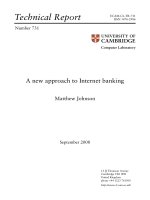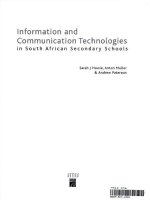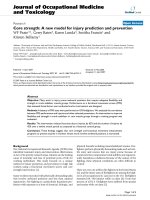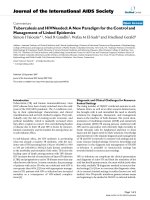A new approach for healthcare information and communication systems
Bạn đang xem bản rút gọn của tài liệu. Xem và tải ngay bản đầy đủ của tài liệu tại đây (417.82 KB, 12 trang )
International Journal of Computer Networks and Communications Security
VOL. 3, NO. 5, MAY 2015, 208–219
Available online at: www.ijcncs.org
E-ISSN 2308-9830 (Online) / ISSN 2410-0595 (Print)
SECURITY & PRIVACY BY DESIGN:
A new approach for Healthcare Information and Communication
Systems
Anas ABOU EL KALAM1, Jean-Philippe LEROY2, Larbi BESSA3 and Jean-Marie MAHE4
1, 2, 3, 4
IPI –LISER / Propedia, Paris, France
E-mail: 1aabouelkalam, 2jpleroy, 3l.bessa, 4jmmahe}@groupe-igs.fr
ABSTRACT
Nowadays, more and more applications use sensitive and personal information. Subsequently, respecting
citizens’ privacy while preserving information security is becoming extremely important. Initially,
deploying security mechanisms as well as Privacy-Enhancing Technologies (PETs) was seen as the
solution. Today, we realize that a more substantial approach is required, taking into account the security
and privacy needs from the earlier steps of the system specification. Dedicated to this issue, this paper is
organized as follows: after defining the topic through several examples, this paper analyzes the most typical
anonymization procedures used in various countries and presents the main privacy-related concepts. Then,
it suggests a rigorous approach to define suitable anonymization solutions and mechanisms through the
needs, objectives and requirements. Afterwards, a representative range of scenarios is presented and
confronted to the approach already described. Finally, a new generic procedure to anonymize and link
identities is suggested. Details about the implementation and analysis of our solution are also presented.
Our approach takes the purpose of use into consideration, guarantees the citizen’s consent, resists dictionary
attacks, respects the least privilege principle and thus fulfills the European legislation requirements. Even if
our approach is applied in this paper to healthcare examples, it could also be suitable to every system with
security and privacy needs.
Keywords: Anonymization, Security, Privacy, Health Care, Electronic Medical Records.
1
INTRODUCTION
For the time being, we can assert that international [1], American [2,3,4] and European
legislations are not only worried about protecting
personal and nominative data, but also aim at
forbidding files linkage [5, 6, 7, 8]. Moreover, in
many organizations, privacy is considered as a
purely legal issue; and a big gap persists between
its identification and implementation. Worst,
security and privacy are sometimes considered as
separate issues, and the deployed security mechanisms often threaten privacy. For example, in
healthcare systems, authentication and traceability
mechanisms are used to identify reliably the
patients; on the other hand, strong security may
endanger the patient’s privacy.
To satisfy the privacy-related legislations,
countries and institutions uses classical Privacy-
Enhancing Technologies (PETs) such as
anonymization [9, 10, 11, 12].
However, classical mechanisms are not satisfying
in complex systems as it is sometimes possible to
identify a person by linking non-nominative data,
by breaking the privacy mechanisms or by using
inference techniques. For instance, the age, the sex
and the month of discharge from hospital are
enough to identify the patient in a limited
population. Likewise, it is commonly known that
two childbirth dates is enough to identify a woman
in a sizeable population.
In this paper, we explain that the privacy (as well
as security) should be studied from the earlier
phases of the system specification, taking into
account the needs, the objectives and the
requirements. We thus propose a systematic
methodology that progressively derives the privacy
209
A. A. E. Kalam et. al / International Journal of Computer Networks and Communications Security, 3 (5), May 2015
related mechanisms, and we apply it to the
healthcare system.
Subsequently, this paper is organized as follows:
Section 2 explains classical solutions and shows
their main drawbacks. To overcome these
limitations, Section 3 proposes a systematic methodology that first analyzes the privacy needs,
specifies the privacy objectives and finally derives
the privacy requirements. Once these steps
achieved, it would be possible to identify the
suitable mechanisms that satisfies the needs and
overcomes the risks. To show the usability of our
methodology, we apply it to healthcare information
and communication systems. Subsequently, we
derive in Section 4 a generic solution based on the
main steps of our methodology. Afterward, a
security analysis of our work is proposed in Section
5. Finally, Section 6 concludes our work and
perspectives.
2
CLASSICAL SOLUTIONS
Healthcare organizations represent excellent
examples of systems with strict security and
privacy needs. In fact, in order to make the accurate
diagnoses and provide the best treatment, patients
naturally provide and share sensitive personal
information with their healthcare professionals.
This information may also be shared with others,
such as insurance companies, pharmacies, researchers, and employers, for many reasons. If patients
are not confident that this information will be kept
confidential, they will not be forthright and reveal
accurate and complete information. Moreover, if
healthcare providers are not confident that the
organization that is responsible for the healthcare
record will keep it confidential they will limit what
patients add to the record. Either of these actions is
likely to result in inferior healthcare. Subsequently,
several laws and rules have been published to
protect the privacy and security of personal health
information. To enforce these legislations, each
country has taken the necessary measures and
deployed the suitable measures.
For instance, several French hospitals use an
anonymization protocol [13] that transforms patient
identities by using a one-way hash function (SHA).
The principle is to ensure an irreversible transformation of a set of identifying variables (name, date
of birth, sex). In order to link all the information
concerning the same patient, the anonymous code
obtained is always the same for the given
individual.
However, this procedure is vulnerable to dictionary attacks (e.g., by comparing hashed known
identities with the code assigned to a particular
patient). In order to avoid such attacks, two keys
have been added before applying SHA. The first
pad, k1, is used by all senders of information as
follow “Code1 = H(k1 | Identity)”; and the second,
k2, is applied by the recipient “Code2 = H(k2 +
Code1)”. Nominal information is therefore hashed
twice, consecutively with these two keys. The aim
of pad k1 (resp. k2) is to prevent attacks by a
recipient (resp. a sender).
However, this protocol is both complex and
risky: the secret key should be the same for all
information issuers (clinicians, hospitals) and stay
the same over time. Moreover, this key must
always remain secret: if it is corrupted, the security
level is considerably reduced. It’s very difficult to
keep a key secret during a long time, especially if it
is largely distributed. This means that new keys
have to be distributed periodically. The same
problem occurs when the hash algorithm (or the
key length) is proven not sufficiently robust any
more. But, how can we link all the information
concerning the same patient when it becomes
necessary to change the algorithm or the key? If
this problem occurs, the only possible solution
consists in applying another cryptographic
transformation to the entire database, which may be
very costly.
In Germany, the National Cancer Registry
(GNCR) is used for collecting medical statistics
related to cancer. The procedure of the populationbased cancer registration is carried out in two steps
by two institutions [14]. In the first step, the
Trusted Site collects the tumor-related data
recorded by doctors, dentists or Follow-up
Organization Centers. The Trusted Site anonymizes
the patient’s personal data by an asymmetric
procedure, e.g., a hybrid IDEA-RSA encoding: the
identifying data is encrypted with an IDEA session
key, generated randomly; the IDEA key is then
ciphere����������������������������������������������������������������������������������������������������������������������������������������������������������������������������������������������������������������������������������������������������������������������������������������������������������������������������������������������������������������������������������������������������������������������������������������������������������������������������������������������������������������������������������������������������������������������������������������������������������������������������������������������������������������������������������������������������������������������������������������������������������������������������������������������������������������������������������������������������������������������������������������������������������������������������������������������������������������������������������������������������������������������������������������������������������������������������������������������������������������������������������������������������������������������������������������������������������������������������������������������������������������������������������������������������������������������������������������������������������������������������������������������������������������������������������������������������������������������������������������������������������������������������������������������������������������������������������������������������������������������������������������������������������������������������������������������������������������������������������������������������������������������������������������������������������������������������������������������������������������������������������������������������������������������������������������������������������������������������������������������������������������������������������������������������������������������������������������������������������������������������������������������������������������������������������������������������������������������������������������������������������������������������������������������������������������������������������������������������������������������������������������������������������������������������������������������������������������������������������������������������������������������������������������������������������������������������������������������������������������������������������������������������������������������������������������������������������������������������������������������������������������������������������������������������������������������������������������������������������������������������������������������������������������������������������������������������������������������������������������������������������������������������������������������������������������������������������������������������������������������������������������������������������������������������������������������������������������������������������������������������������������������������������������������������������������������������������������������������������������������������������������������������������������������������������������������������������������������������������������������������������������������������������������������������������������������������������������������������������������������������������������������������������������������������������������������������������������������������������������������������������������������������������������������������������������������������������������������������������������������������������������������������������������������������������������������������������������������������������������������������������������������������������������������������������������������������������������������������������������������������������������������������������������������������������������������������������������������������������������������������������������������������������������������������������������������������������������������������������������������������������������������������������������������������������������������������������������������������������������������������������������������������������������������������������������������������������������������������������������������������������������������������������������������������������������������������������������������������������������������������������������������������������������������������������������������������������������������������������������������������������������������������������������������������������������������������������������������������������������������������������������������������������������������������������������������������������������������������������������������������������������������������������������������������������������������������������������������������������������������������������������������������������������������������������������������������������������������������������������������������������������������������������������������������������������������������������������������������������������������������������������������������������������������������������������������������������������������������������������������������������������������������������������������������������������������������������������������������������������������������������������������������������������������������������������������������������������������������������������������������������������������������������������������������������������������������������������������������������������������������������������������������������������������������������������������������������������������������������������������������������������������������������������������������������������������������������������������������������������������������������������������������������������������������������������������������������������������������������������������������������������������������������������������������������������������������������������������������������������������������������������������������������������������������������������������������������������������������������������������������������������������������������������������������������������������������������������������������������������������������������������������������������������������������������������������������������������������������������������������������������������������������������������������������������������������������������������������������������������������������������������������������������������������������������������������������������������������������������������������������������������������������������������������������������������������������������������������������������������������������������������������������������������������������������������������������������������������������������������������������������������������������������������������������������������������������������������������������������������������������������������������������������������������������������������������������������������������������������������������������������������������������������������������������������������������������������������������������������������������������������������������������������������������������������������������������������������������������������������������������������������������������������������������������������������������������������������������������������������������������������������������������������������������������������������������������������������������������������������������������������������������������������������������������������������������������������������������������������������������������������������������������������������������������������������������������������������������������������������������������������������������������������������������������������������������������������������������������������������������������������������������������������������������������������������������������������������������������������������������������������������������������������������������������������������������������������������������������������������������������������������������������������������������������������������������������������������������������������������������������������������������������������������������������������������������������������������������������������������������������������������������������������������������������������������������������������������������������������������������������������������������������������������������������������������������������������������������������������������������������������������������������������������������������������������������������������������������������������������������������������������������������������������������������������������������������������������������������������������������������������������������������������������������������������������������������������������������������������������������������������������������������������������������������������������������������������������������������������������������������������������������������������������������������������������������������������������������������������������������������������������������������������������������������������������������������������������������������������������������������������������������������������������������������������������������������������������������������������������������������������������������������������������������������������������������������������������������������������������������������������������������������������������������������������������������������������������������������������������������������������������������������������������������������������������������������������������������������������������������������������������������������������������������������������������������������������������������������������������������������������������������������������������������������������������������������������������������������������������������������������������������������������������������������������������������������������������������������������������������������������������������������������������������������������������������������������������������������������������������������������������������������������������������������������������������������������������������������������������������������������������������������������������������������������������������������������������������������������������������������������������������������������������������������������������������������������������������������������������������������������������������������������������������������������������������������������������������������������������������������������������������������������������������������������������������������������������������������������������������������������������������������������������������������������������������������������������������������������������������������������������������������������������������������������������������������������������������������������������������������������������������������������������������������������������������������������������������������������������������������������������������������������������������������������������������������������������������������������������������������������������������������������������������������������������������������������������������������������������������������������������������������������������������������������������������������������������������������������������������������������������������������������������������������������������������������������������������������������������������������������������������������������������������������������������������������������������������������������������������������������������������������������������������������������������������������������������������������������������������������������������������������������������������������������������������������������������������������������������������������������������������������������������������������������������������������������������������������������������������������������������������������������������������������������������������������������������������������������������������������������������������������������������������������������������������������������������������������������������������������������������������������������������������������������������������������������������������������������������������������������������������������������������������������������������������������������������������������������������������������������������������������������������������������������������������������������������������������������������������������������������������������������������������������������������������������������������������������������������������������������������������������������������������������������������������������������������������������������������������������������������������������������������������������������������������������������������������������������������������������������������������������������������������������������������������������������������������������������������������������������������������������������������������������������������������������������������������������������������������������������������������������������������������������������������������������������������������������������������������������������������������������������������������������������������������������������������������������������������������������������������������������������������������������������������������������������������������������������������������������������������������������������������������������������������������������������������������������������������������������������������������������������������������������������������������������������������������������������������������������������������������������������������������������������������������������������������������������������������������������������������������������������������������������������������������������������������������������������������������������������������������������������������������������������������������������������������������������������������������������������������������������������������������������������������������������������������������������������������������������������������������������������������������������������������������������������������������������������������������������������������������������������������������������������������������������������������������������������������������������������������������������������������������������������������������������������������������������������������������������������������������������������������������������������������������������������������������������������������������������������������������������������������������������������������������������������������������������������������������������������������������������������������������������������������������������������������������������������������������������������������������������������������������������������������������������������������������������������������������������������������������������������������������������������������������������������������������������������������������������������������������������������������������������������������������������������������������������������������������������������������������������������������������������������������������������������������������������������������������������������������������������������������������������������������������������������������������������������������������������������������������������������������������������������������������������������������������������������������������������������������������������������������������������������������������������������������������������������������������������������������������������������������������������������������������������������������������������������������������������������������������������������������������������������������������������������������������������������������������������������������������������������������������������������������������������������������������������������������������������������������������������������������������������������������������������������������������������������������������������������������������������������������������������������������������������������������������������������������������������������������������������������������������������������������������������������������������������������������������������������������������������������������������������������������������������������������������������������������������������������������������������������������������������������������������������������������������������������������������������������������������������������������������������������������������������������������������������������������������������������������������������������������������������������������������������������������������������������������������������������������������������������������������������������������������������������������������������������������������������������������������������������������������������������������������������������������������������������������������������������������������������������������������������������������������������������������������������������������������������������������������������������������������������������������������������������������������������������������������������������������������������������������������������������������������������������������������������������������������������������������������������������������������������������������������������������������������������������������������������������������������������������������������������������������������������������������������������������������������������������������������������������������������������������������������������������������������������������������������������������������������������������������������������������������������������������������������������������������������������������������������������������������������������������������������������������������������������������������������������������������������������������������������������������������������������������������������������������������������������������������������������������������������������������������������������������������������������������������������������������������������������������������������������������������������������������������������������������������������������������������������������������������������������������������������������������������������������������������������������������������������������������������������������������������������������������������������������������������������������������������������������������������������������������������������������������������������������������������������������������������������������������������������������������������������������������������������������������������������������������������������������������������������������������������������������������������������������������������������������������������������������������������������������������������������������������������������������������������������������������������������������������������������������������������������������������������������������������������������������������������������������������������������������������������������������������������������������������������������������������������������������������������������������������������������������������������������������������������������������������������������������������������������������������������������������������������������������������������������������������������������������������������������������������������������������������������������������������������������������������������������������������������������������������������������������������������������������������������������������������������������������������������������������������������������������������������������������������������������������������������������������������������������������������������������������������������������������������������������������������������������������������������������������������������������������������������������������������������������������������������������������������������������������������������������������������������������������������������������������������������������������������������������������������������������������������������������������������������������������������������������������������������������������������������������������������������������������������������������������������������������������������������������������������������������������������������������������������������������������������������������������������������������������������������������������������������������������������������������������������������������������������������������������������������������������������������������������������������������������������������������������������������������������������������������������������������������������������������������������������������������������������������������������������������������������������������������������������������������������������������������������������������������������������������������������������������������������������������������������������������������������������������������������������������������������������������������������������������������������������������������������������������������������������������������������������������������������������������������������������������������������������������������������������������������������������������������������������������������������������������������������������������������������������������������������������������������������������������������������������������������������������������������������������������������������������������������������������������������������������������������������������������������������������������������������������������������������������������������������������������������������������������������������������������������������������������������������������������������������������������������������������������������������������������������������������������������������������������������������������������������������������������������������������������������������������������������������������������������������������������������������������������������������������������������������������������������������������������������������������������������������������������������������������������������������������������������������������������������������������������������������������������������������������������������������������������������������������������������������������������������������������������������������������������������������������������������������������������������������������������������������������������������������������������������������������������������������������������������������������������������������������������������������������������������������������������������������������������������������������������������������������������������������������������������������������������������������������������������������������������������������������������������������������������������������������������������������������������������������������������������������������������������������������������������������������������������������������������������������������������������������������������������������������������������������������������������������������������������������������������������������������������������������������������������������������������������������������������������������������������������������������������������������������������������������������������������������������������������������������������������������������������������������������������������������������������������������������������������������������������������������������������������������������������������������������������������������������������������������������������������������������������������������������������������������������������������������������������������������������������������������������������������������������������������������������������������������������������������������������������������������������������������������������������������������������������������������������������������������������������������������������������������������������������������������������������������������������������������������������������������������������������������������������������������������������������������������������������������������������������������������������������������������������������������������������������������������������������������������������������������������������������������������������������������������������������������������������������������������������������������������������������������������������������������������������������������������������������������������������������������������������������������������������������������������������������������������������������������������������������������������������������������������������������������������������������������������������������������������������������������������������������������������������������������������������������������������������������������������������������������������������������������������������������������������������������������������������������������������������������������������������������������������������������������������������������������������������������������������������������������������������������������������������������������������������������������������������������������������������������������������������������������������������������������������������������������������������������������������������������������������������������������������������������������������������������������������������������������������������������������������������������������������������������������������������������������������������������������������������������������������������������������������������������������������������������������������������������������������������������������������������������������������������������������������������������������������������������������������������������������������������������������������������������������������������������������������������������������������������������������������������������������������������������������������������������������������������������������������������������������������������������������������������������������������������������������������������������������������������������������������������������������������������������������������������������������������������������������������������������������������������������������������������������������������������������������������������������������������������������������������������������������������������������������������������������������������������������������������������������������������������������������������������������������������������������������������������������������������������������������������������������������������������������������������������������������������������������������������������������������������������������������������������������������������������������������������������������������������������������������������������������������������������������������������������������������������������������������������������������������������������������������������������������������������������������������������������������������������������������������������������������������������������������������������������������������������������������������������������������������������������������������������������������������������������������������������������������������������������������������������������������������������������������������������������������������������������������fiers
are the same in the two hospitals (for each
anonymous database associated to a particular
project).
3
KpA is known by all the project centers that HospA
cooperates with, but is not “public”. On the other side, KSA, the
corresponding “private” key, is known only by HospA.
217
A. A. E. Kalam et. al / International Journal of Computer Networks and Communications Security, 3 (5), May 2015
5.2 Transformations carried out upstream from
processing centers
Data contained in the anonymous databases (in
the hospitals) undergoes transformations that
depend on IDAproj|pat and on Kshosp. Every
processing center (project) decrypts received data
by using Kphosp:
[IDAhosp(pat|Proj)] Kphosp
according to (T2), = [ {IDApat|Proj} Kshosp ] Kphosp
= IDApat|Proj
The processing center finds the information that is
sufficient and necessary to its processing. Since this
information is associated to IDApat|Proj, each
project can link data corresponding to the same
patient.
5.3 Transformations carried out
distribution to the final users
before
the
Before their distribution to the final users
(scientist researchers, web publishing, press, etc.)
the anonymized data can undergo a targeted
filtering. For instance, this can be done by applying
a data aggregation, data impoverishment, etc.
If, in addition, the security objective is to forbid
final users to link information, it is advisable to
apply another anonymization (e.g., by MD5) with a
secret key Kutil|proj generated randomly.
IDApat|util = H(IDApat|Proj | Kutil|proj)
In accordance to needs, this last case corresponds
to two different processes:
if the aim is to allow the full time linking (per
project for that particular user), the key
Kutil|proj has to be stored by the processing
center, so that it can reuse this same key when
transmitting information to the same final user;
Inversely, if the center wishes to forbid users
linking data, the key is randomly generated just
before each distribution.
6
DISCUSSION
The suggested generic solution brings mainly the
following benefits:
Every step (technical or organization procedure)
necessitates a judicious prior analysis of privacy
risks, needs, objectives and requirements.
The anonymous patient identifier differs from a
project to another.
The patient’s consent must be provided for each
non-compulsory, but desirable, utilization of his
anonymized data.
The identifiers (IDproj, IDpat, IDApat|Proj and
IDApat|util) used in the various transformations
are located in different places; similarly, the
keys (Kshosp, Kphosp) are held by different
persons. Indeed, IDproj concerns a unique
project; IDpat is specific to one patient, and
only held on his card; the pair (Kshosp, Kphosp)
is specific to one hospital; IDApat|util is
dedicated to a single final user. Therefore, the
risk of illicit disanonymization is considerably
reduced. In the same way, the solution resists to
dictionary attacks that could be led in different
organizations:
healthcare
establishments,
processing centers and final users.
The combination of the suggested anonymization sequence (T1, T2, T3) with access control
mechanisms satisfies the non-inversibility
requirement as well as the least privilege
principle.
It is possible to merge the data belonging to
several establishments without compromising
neither the security nor the flexibility.
In accordance with European legislation, our
solution takes the purpose of use into account.
Moreover its fine-grain analysis allows to easily
adapt it to needs of other sectors (e.g., Ecommerce, E-government, demographic studies,
etc.).
As smart cards are sufficiently tamper-resistant,
their use seems suitable to keep secret the
patient identifier. Moreover, smart cards are an
adequate means to materialize the patient
consent. Indeed, the patient medical data can
appear in a database only if, by supplying his
card, the patient gives his consent to exploit his
medical data as a part of a project.
Besides, our solution regulates the medical data
inversion. Let us take the example where the final
user (i.e. researcher in rare or orphan diseases)
discovers important information that necessitates
re-identifying the patients. At first, it sends back
results to the project center. The latter dispatches
the results to the original hospitals participating to
the concerned study (e.g., the orphan disease
study).
Two cases can be identified:
The original hospital has still the databases (or
files) that allow establishing the link between
the patient’s identifiers, stay identifiers, and
218
A. A. E. Kalam et. al / International Journal of Computer Networks and Communications Security, 3 (5), May 2015
medical data. In this case, the consulting
physician performs the patient identification and
informs him about the new research results.
The hospital has deleted the nominative
databases (for legal reasons or for security
reasons); or the patient goes to a hospital
participating to the project, but not the hospital
where he was treated before. In these cases, by
providing his medical data card (which implies
that he gives explicitly his consent), it is
possible to calculate IDApat|Proj = H(IDproj |
IDpat)
and
IDAhosp(pat|Proj)
=
{IDApat|Proj}Kshosp, and then, to establish the
link between the patient, his anonymous
identifiers, and his medical data. A simple (and
automatic) comparison between the anonymous
identifier and the inversion list4, would allow
setting off an alarm. This alarm asks the patient
if he wants to consult the results. Of course, if
the knowledge of these results can harm the
patient, it should contain a mention advising the
patient to contact his consulting physician. The
latter will inform him, in a suitable manner,
about the results.
Furthermore, according to the security needs of
the studied case, we suggest to complement our
solution by other technical and organizational
security mechanisms:
The access to data has to be perfectly
controlled; a well-defined security policy must
be implemented by appropriate security
mechanisms (hardware and/or software);
The information system specification as well as
the network architecture have to obey to a
global security policy, and have to be adapted to
needs;
In some particular contexts, it is more efficient
to completely separate identifier data from
medical data.
For repression or for deterring, it is recommended to control the purpose of use by calling for
intrusion detection mechanisms; in particular,
these mechanisms should detect malicious
requests, illicit inferences, abuse of power, etc.
7
CONCLUSION
In an electronic dimension that becomes
henceforth omnipresent, this paper responds to one
of the major recent concerns, fathered by the new
4
This list is sent by the final user (i.e. the scientific
researcher). It contains the anonymous identifiers with the
results.
information and communication technologies: the
respect of privacy.
In this framework, we firstly analyzed the
anonymization in the medical area, by identifying
and studying some representative scenarios.
Secondly, we have presented an analytic approach
putting in correspondence anonymization functionalities and adequate solutions. Finally, we
suggested a new procedure adapted to privacy
needs, objectives and requirements of healthcare
information and communication systems. This finegrain procedure is generic, flexible and could be
adapted to different sectors. The use of smartcards
in this procedure responds to many security needs.
Although this solution is based on several
successive anonymization steps, the cryptographic
mechanisms that it uses are not expensive in terms
of time and computation resources, and are
compatible with current smartcard technology.
Using Java Cards, we have implemented a
prototype of this solution with a complete medical
scenario, and we will soon be able to measure the
performance and complexity of a real application.
8
REFERENCES
[1] The resolution A/RES/45/95 of the General
assembly of United Nations: “Guidelines for
the Regulation of Computerized Data Files”;
14 December 1990.
[2] U.S. Department of Health & Human Services,
Update on the HIPAA Privacy and Security
Final Rule, January 17, 2013.
[3] “Long-expected
omnibus
HIPAA
rule
implements significant privacy and security
regulations for entities and business associates”
Mayer Brown LLP, February 11, 2013.
[4] “HITECH Final Rule Results in Significant
Changes to HIPAA Provisions” Faegre Baker
Daniels, January 30, 2013.
[5] Directive 2002/58/EC of the European
Parliament on: “the processing of personal data
and the protection of privacy in the electronic
communications sector”; July, 12 2002.
[6] Directive 95/46/CE of the European
Parliament: “On the protection of individuals”;
October 24, 1995.
[7] Recommendations R(97)5 of the Council of
Europe, On The Protection of Medical Data
Banks, Council of Europe, Strasbourg, 13
février 1997.
[8] Loi 78-17 du 6 janvier 1978 relative à
l’Informatique, aux fichiers et aux libertés,
Journal officiel, pp. 227-231
[9] B. Claerhouta, G.J.E. DeMoor, "Privacy
protection for clinical and genomic data: The
219
A. A. E. Kalam et. al / International Journal of Computer Networks and Communications Security, 3 (5), May 2015
use of privacy-enhancing techniques in
medicine", International Journal of Medical
Informatics, Volume 74, Issues 2–4, March
2005, Pages 257–265, Elsevier.
[10] M. Hansen, P. Berlich, J. Camenisch, S. Clauß,
A. Pfitzmann, M. Waidner, "Privacy-enhancing
identity management", Information Security
Technical Report, Volume 9, Issue 1, January–
March 2004, Pages 35–44, Elseiver.
[11] M. Rahman, B. Carbunar, M. Banik, “Fit and
Vulnerable: Attacks and Defenses for a Health
Monitoring Device”, 13th Privacy Enhancing
Technologies Symposium (PETS 2013),
Bloomington, Indiana, USA, July 10 – 12,
2013, Springer LNCS.
[12] A. Abou El Kalam, Carlos Aguilar-Melchor, S.
Berthold, J. Camenish, S. Clauß, Y. Deswarte,
M. Kohlweiss, A. Panchenko, L. Pimenidis, M.
Roy "Further Privacy Mechanisms", Chapter
18, in Digital Privacy: PRIME — Privacy and
Identity Management for Europe, Jan
Camenisch, Ronald Leenes & Dieter Sommer
(Eds.), Springer, Lecture Notes in Computer
Science (LNCS 6545), 2011, ISBN 9783642190490.
[13] C. Quantin, H. Bouzelat, FA. Allaert, AM.
Benhamiche, J. Faivre et L. Dusserre, “How to
ensure data security of an epidemiological
follow-up”, Medical Informatics 49 (1998).
[14] B Blobel, “Clinical Record Systems in
Oncology. Experiences and Developments on
Cancer Registers in Eastern Germany”,
Personal Medical Information Security,
Engineering and Ethics, ISBN 3-540-63244-1,
997.
[15] J.P. Jeanneret, D. Olivier, J. Chiffelle, “How to
Protect Patient’s medical Secret in Official
statistic”, Information Security Solutions
Europe Conference, London, 2001.
[16] Common Criteria for Information Technology
Security Evaluation, Part 1: Introduction and
general model, 60 p., ISO/IEC 15408-1 (1999).
[17] A. Menezes, P. C. Van Oorshot, S. A.
Vanstone,
“Handbook
of
Applied
Cryptography”, 1997, CRC press, ISBN :
0849385237, pp. 780.









